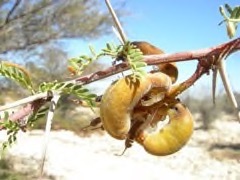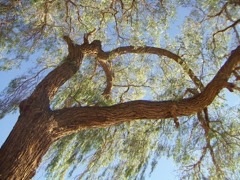 |
|
Hans Peter Möller - Flickr |
 |
| Pablo Trincado - Flickr |
Translate this page:
Summary
Prosopis tamarugo is a very drought and salt tolerant tree. It participates in hydraulic redistribution moving water from deeper levels to the upper and also reversing the process in times of severe drought. Often found in areas where there is no rain for years at a time; however, at night there is a high relative humidity and the trees absorb moisture through the leaves. The trees will grow on saline soils that do not allow for other trees.
Physical Characteristics

 Prosopis tamarugo is a deciduous Tree growing to 12 m (39ft) by 10 m (32ft) at a fast rate.
Prosopis tamarugo is a deciduous Tree growing to 12 m (39ft) by 10 m (32ft) at a fast rate.
See above for USDA hardiness. It is hardy to UK zone 10. The flowers are pollinated by Bees.
It can fix Nitrogen.
It is noted for attracting wildlife.
Suitable for: light (sandy), medium (loamy) and heavy (clay) soils, prefers well-drained soil and can grow in nutritionally poor soil. Suitable pH: neutral and basic (mildly alkaline) soils and can grow in very alkaline and saline soils.
It cannot grow in the shade. It prefers dry or moist soil and can tolerate drought. The plant can tolerates strong winds but not maritime exposure.
UK Hardiness Map
US Hardiness Map
Synonyms
No synonyms are recorded for this name.
Plant Habitats
Edible Uses
Edible Parts: Seedpod
Edible Uses:
The pods can be leached and used for food[418 ].
References More on Edible Uses
Medicinal Uses
Plants For A Future can not take any responsibility for any adverse effects from the use of plants. Always seek advice from a professional before using a plant medicinally.
None known
References More on Medicinal Uses
The Bookshop: Edible Plant Books
Our Latest books on Perennial Plants For Food Forests and Permaculture Gardens in paperback or digital formats.

Edible Tropical Plants
Food Forest Plants for Hotter Conditions: 250+ Plants For Tropical Food Forests & Permaculture Gardens.
More

Edible Temperate Plants
Plants for Your Food Forest: 500 Plants for Temperate Food Forests & Permaculture Gardens.
More

More Books
PFAF have eight books available in paperback and digital formats. Browse the shop for more information.
Shop Now
Other Uses
Fodder
Agroforestry Uses: The tree is being planted in large numbers in northern Chile in a reforestation project - it is the only tree that can grow in such a harsh, arid climate[491 ]. Nitrogen. Other Uses: The wood is very heavy and very hard - making it difficult to work with[303 ]. It is used for furniture, and construction[418 ]. The wood is used for fuel and making charcoal[418 ].Fodder: Pod, Bank. At Pampa del Tamarugal, a silvopastoral system with small ruminants was established. The mature fruit and dry leaves of tamarugo fall on the soil and can be used as fodder for goats, sheep and cows.The leaves and the fruits of tamarugo, around 7000–9000 sheep and goats can survive in an original desert region. In fact, a 14–22 years old tree can produce 20–70 kg of fodder per year.
Special Uses
Carbon Farming
References More on Other Uses
Cultivation details
Agroforestry Services: Nitrogen Fodder: Bank Fodder: Pod Management: Coppice Management: Standard Regional Crop
The plant occurs naturally in arid areas of the tropics, within the latitudinal range 18 - 21°S, at elevations from 1,000 - 2,500 metres[418 ]. It grows best in areas where annual daytime temperatures are within the range 18 - 32°c, but can tolerate 8 - 36°c[418 ]. Dormant plants can be killed by temperatures of -12°c or lower, though fresh young growth can be killed at -1°c[418 ]. It prefers a mean annual rainfall in the range 150 - 250mm, but tolerates 100 - 300mm[418 ]. It is often found in areas where there is no rain for years at a time; however, at night there is a high relative humidity and the trees absorb moisture through the leaves[418 ]. Requires a sunny position. Succeeds on salty, salty-sandy or clay-loam soils, sometimes with a 40cm salt encrustation at the surface[303 ]. Prefers a pH in the range 7 - 8, tolerating 6.5 - 8.5[418 ]. Established plants are very drought resistant, able to go for 12 months or more without rain[418 ]. Under less harsh conditions that the plant experiences in its native environment, the plant might spread uncontrollably and become a serious weed[418 ]. Trees can reach 10 metres in height within 15 years, even under harsh conditions[418 ]. The tree coppices well, regenerating rapidly when cut back[303 , 418 ]. Annual wood production potential is 2 - 4 cubic metres per hectare[418 ]. This species has a symbiotic relationship with certain soil bacteria, these bacteria form nodules on the roots and fix atmospheric nitrogen. Some of this nitrogen is utilized by the growing plant but some can also be used by other plants growing nearby[755 ].
Carbon Farming
-
Agroforestry Services: Nitrogen
Plants that contribute to nitrogen fixation include the legume family – Fabaceae.
-
Fodder: Bank
Fodder banks are plantings of high-quality fodder species. Their goal is to maintain healthy productive animals. They can be utilized all year, but are designed to bridge the forage scarcity of annual dry seasons. Fodder bank plants are usually trees or shrubs, and often legumes. The relatively deep roots of these woody perennials allow them to reach soil nutrients and moisture not available to grasses and herbaceous plants.
-
Fodder: Pod
Fodder plants with pods.
-
Management: Coppice
Cut to the ground repeatedly - resprouting vigorously. Non-destructive management systems maintaining the soil organic carbon.
-
Management: Standard
Plants grow to their standard height. Harvest fruit, seeds, or other products. Non-Destructive management systems.
-
Regional Crop
These crops have been domesticated and cultivated regionally but have not been adopted elsewhere and are typically not traded globally, Examples in this broad category include perennial cottons and many nuts and staple fruits.
References Carbon Farming Information and Carbon Sequestration Information
Temperature Converter
Type a value in the Celsius field to convert the value to Fahrenheit:
Fahrenheit:
The PFAF Bookshop
Plants For A Future have a number of books available in paperback and digital form. Book titles include Edible Plants, Edible Perennials, Edible Trees,Edible Shrubs, Woodland Gardening, and Temperate Food Forest Plants. Our new book is Food Forest Plants For Hotter Conditions (Tropical and Sub-Tropical).
Shop Now
Plant Propagation
Seed
Other Names
If available other names are mentioned here
Tamarugo
Native Range
SOUTHERN AMERICA: Chile (Antofagasta, Arica y Parinacota, Tarapacá)
Weed Potential
Right plant wrong place. We are currently updating this section.
Please note that a plant may be invasive in one area but may not in your area so it's worth checking.
Under less harsh conditions that the plant experiences in its native environment, the plant might spread uncontrollably and become a serious weed[418 ].
Conservation Status
IUCN Red List of Threatened Plants Status : Status: Lower Risk/conservation dependent

Growth: S = slow M = medium F = fast. Soil: L = light (sandy) M = medium H = heavy (clay). pH: A = acid N = neutral B = basic (alkaline). Shade: F = full shade S = semi-shade N = no shade. Moisture: D = dry M = Moist We = wet Wa = water.
Now available:
Food Forest Plants for Mediterranean Conditions
350+ Perennial Plants For Mediterranean and Drier Food Forests and Permaculture Gardens.
[Paperback and eBook]
This is the third in Plants For A Future's series of plant guides for food forests tailored to
specific climate zones. Following volumes on temperate and tropical ecosystems, this book focuses
on species suited to Mediterranean conditions—regions with hot, dry summers and cool, wet winters,
often facing the added challenge of climate change.
Read More
Expert comment
Author
F.Phil.
Botanical References
Links / References
For a list of references used on this page please go here
A special thanks to Ken Fern for some of the information used on this page.
Readers comment
| Add a comment |
|
If you have important information about this plant that may help other users please add a comment or link below. Only comments or links that are felt to be directly relevant to a plant will be included. If you think a comment/link or information contained on this page is inaccurate or misleading we would welcome your feedback at [email protected]. If you have questions about a plant please use the Forum on this website as we do not have the resources to answer questions ourselves.
* Please note: the comments by website users are not necessarily those held by PFAF and may give misleading or inaccurate information.
To leave a comment please Register or login here All comments need to be approved so will not appear immediately.
|
Subject : Prosopis tamarugo
|
|
|
|